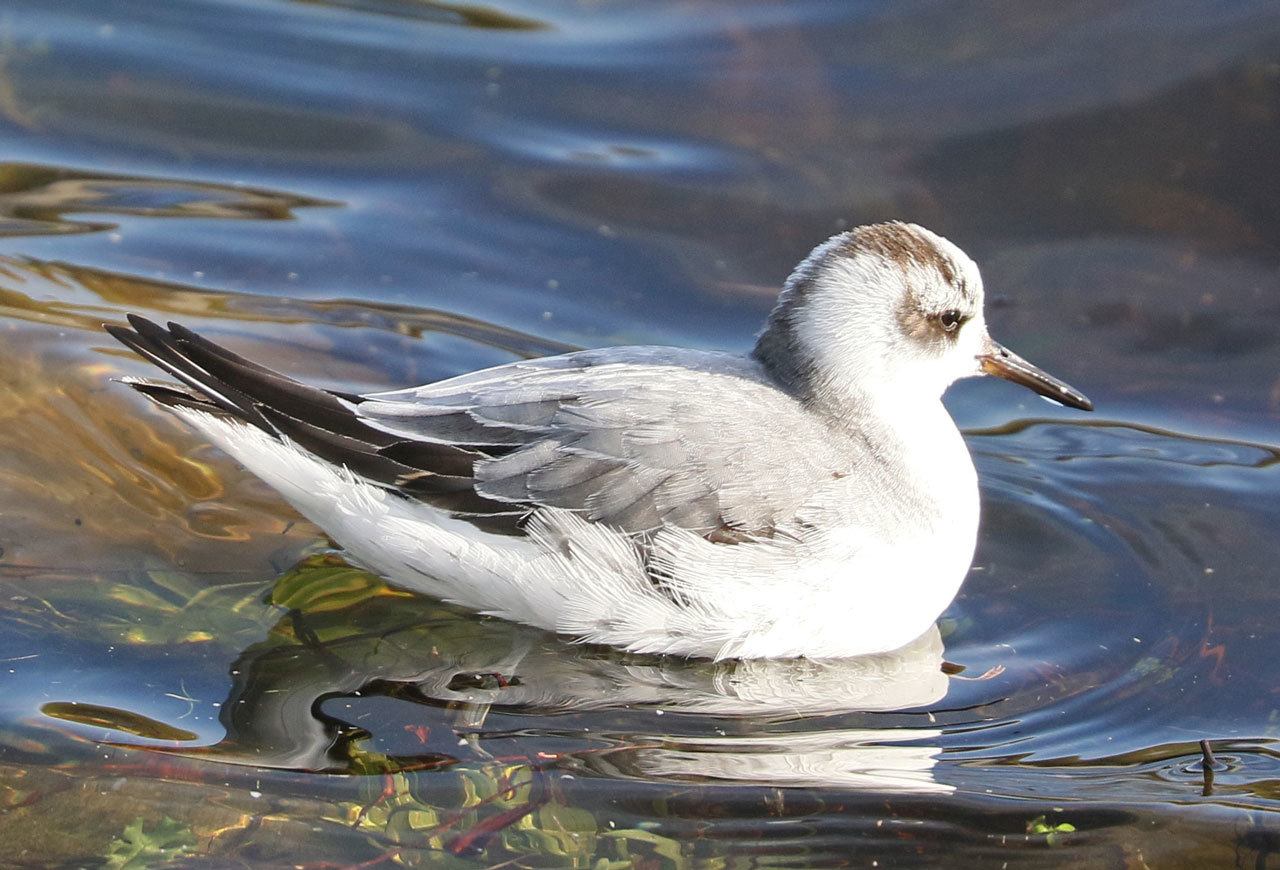Right now Red Phalaropes seem to be the “bird du jour” in the state of Washington, so I thought I would give you a glimpse of this elegant visitor to our shores. It is the most pelagic of the three phalaropes, spending up to 11 months of the year at sea. We seldom see them until heavy storms shove them inland, usually in sewage treatment ponds or sheltered waters. They spend winter just offshore but are seldom seen on land. This photo by Charlotte Byers was taken over the Thanksgiving weekend at the Ocean Shores sewage treatment pond.
General Description: Red Phalaropes are a medium-sized sandpiper, at 8 1/2 inches in length with a 17-inch wingspan, and weighing a mere 2 ounces. We see them in their winter plumage which is mostly black and white. The female is larger and the more colorful of the two sexes, the bill is thicker and shorter, legs are shorter, and the back is paler gray than the similar Red-necked Phalarope.
Habitat: As I mentioned earlier, we only see these birds in the winter, and then infrequently in normal times. Their preferred winter habitat is offshore where merging currents and upwelling cold water brings their food within reach. Their summer breeding territory is in the far north coastal tundra.
Behavior: Red Phalaropes spend their time on the open sea feeding on small sea-going creatures found on the surface of the water, on kelp mats, and even picking parasites off the backs of whales! They can be seen swimming in tight circles to stir up the creatures in shallower waters.
Diet: The winter diet is not well studied, listed only as “zooplankton”; their breeding foraging consists of small crustaceans and mollusks and a variety of invertebrates, especially larval and adult insects.
Nesting: Both sexes pick nesting site and build a scrape-type nest on the moist areas of flat tundra, on sedge-covered ground and covered with an overhanging canopy of grasses. The female lays 4 eggs then leaves the rest of the care to the male. He incubates 18 to 20 days. The young leave the nest the same day as hatching and are able to find their own food, though the male is around to show them the good feeding spots. The male may leave right after the young hatch or stay until the young fledge, at about 18 days.
Migration: Adult females and failed-breeding males begin heading to the coast in late June, with young birds following at a slower pace as they stage and feed in ponds along the route. The timing is often weather-related. The north-bound migration is so offshore that it has not been well-studied, but it has been observed the migrants use opening leads in the Bering Sea to rest until the nesting areas are snow-free. The large flocks of birds are usually found on these leads in mid to late April.
Conservation Status: It is estimated there are approximately 1,000,000 Red Phalaropes globally. They are doing well but still vulnerable to oil spills at sea and encroaching human habitation. Their greatest challenge is the increasing climate change and only time will tell how that effects them.
When and Where to Find in Grays Harbor: While rare to uncommon here on the harbor, a pelagic boat trip is usually the best way to see these birds…until we have a series of Pacific storms that drives them inland to quiet and sheltered ponds. Right now they can be seen in the Tokeland Marina (technically in Pacific County but close enough), Westport Marina and beaches, and in the Ocean Shores and Hoquiam sewage ponds. They are also reported being seen on the outer beaches, foraging in the sand.


